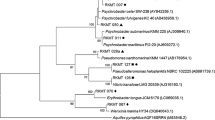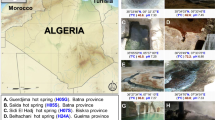Abstract
Twelve kinds of strains were isolated from deep-sea mud which can use Antarctic krill powder as the sole carbon/nitrogen source. These strains were identified by 16s rDNA sequence analysis and grouped into eight different genera, including Bacillus, Shewanella, Psychrobacter, Klebsiella, Macrococcus, Aeromonas, Acinetobacter, and Saccharomyces. After fermentation of Antarctic krill powder using these strains, bioactive compounds including total phenolics, free amino acids, and enzyme activities were investigated. Meanwhile, antioxidant activities of the fermentation liquors were also detected. Results showed that bioactive compounds could be effectively produced through fermentation process by these strains, of which three strains (Bacillus subtilis OKF04, Macrococcus caseolyticus OKF09, and Aeromonas veronii OKF10) could produce more than 650 mg/L total phenolics or 2000 mg/L total free amino acids. In terms of enzyme activities, almost all of the strains showed protease activity and amylase activity, but only Bacillus cereus OKF01 and Bacillus megaterium OKF05 performed lipase activity and chitinase activity, respectively. All of the fermentation liquors showed antioxidant activity, within which Bacillus megaterium OKF05, Macrococcus caseolyticus OKF09, and Aeromonas veronii OKF10 displayed it more prominently. These results demonstrate that the Antarctic krill powder could be effectively converted by microorganisms isolated from deep-sea mud for production of bioactive compounds mixture.


Similar content being viewed by others
References
Atkinson, A., Siegel, V., Pakhomov, E., & Rothery, P. (2004). Long-term decline in krill stock and increase in salps within the Southern Ocean. Nature, 432, 100–103.
Lancraft, T. M., Reisenbichler, K. R., Robison, B. H., Hopkins, T. L., & Torres, J. J. (2004). A krill-dominated micronekton and macrozooplankton community in Croker Passage, Antarctica with an estimate of fish predation. Deep Sea Research Part I: Oceanographic Research Papers, 51, 2247–2260.
Chen, Y. C., Tou, J., & Jaczynski, J. (2009). Amino acid and mineral composition of protein and other components and their recovery yields from whole antarctic krill (Euphausia superba) using isoelectric solubilization/precipitation. Journal of Food Science, 74, H31–H39.
Si, Y. X., Fang, N. Y., Wang, W., Wang, Z. J., Yang, J. M., Qian, G. Y., Yin, S. J., & Park, Y. D. (2014). Folding studies of arginine kinase from Euphausia superba using denaturants. Applied Biochemistry and Biotechnology, 172, 3888–3901.
Gigliotti, J. C., Davenport, M. P., Beamer, S. K., Tou, J. C., & Jaczynski, J. (2011). Extraction and characterisation of lipids from Antarctic krill (Euphausia superba). Food Chemistry, 125, 1028–1036.
Wang, L. Z., Xue, C. H., Wang, Y. M., & Yang, B. (2011). Extraction of proteins with low fluoride level from antarctic krill (Euphausia superba) and their composition analysis. Journal of Agricultural and Food Chemistry, 59, 6108–6112.
Wang, Y. C., Chang, Y. G., Yu, L., Zhang, C. Y., Xu, X. Q., Xue, Y., Li, Z. J., & Xue, C. H. (2013). Crystalline structure and thermal property characterization of chitin from antarctic krill (Euphausia superba). Carbohydrate Polymers, 92, 90–97.
Zhu, L. H., & Xu, X. Q. (2013). Stimulatory effect of different lignocellulosic materials for phenolic compound production and antioxidant activity from Inonotus obliquus in submerged fermentation. Applied Biochemistry and Biotechnology, 169, 2138–2152.
Ren, Y. L., Zhou, J. Y., Zhang, X. Y., Li, Z. D., Zhong, J., Yang, J., Xu, T., & Tan, H. (2012). Analysis of free amino acids during fermentation by Bacillus subtilis using capillary electrophoresis. Biotechnology and Bioprocess Engineering, 17, 1244–1251.
Priya, J. D. A., Divakar, K., Prabha, M. S., Selvam, G. P., & Gautam, P. (2014). Isolation, purification and characterisation of an organic solvent-tolerant Ca2+-dependent protease from Bacillus megaterium AU02. Applied Biochemistry and Biotechnology, 172, 910–932.
Angusamy, A., Abdul, K. K. A. J., Syed, K. S. M., Shunmugiah, K. P., & Arumugam, V. R. (2012). Inhibition of quorum sensing mediated virulence factors production in urinary pathogen Serratia marcescens PS1 by marine sponges. Indian Journal of Microbiology, 2012, 160–166.
Dhivya, B., Arulanandu, S. B., Arumugam, V., Ramachandran, S. S., Kandasamy, D., & Paramasivam, N. (2014). Antioxidant activity of bacteria associated with the marine sponge Tedania anhelans. Indian Journal of Microbiology. doi:10.1007/s12088-014-0490-8.
Chen, Y. C., Chiang, T. J., Liang, T. W., Wang, I. L., & Wang, S. L. (2012). Reclamation of squid pen by Bacillus licheniformis TKU004 for the production of thermally stable and antimicrobial biosurfactant. Biocatalysis and Agricultural Biotechnology, 1, 62–69.
Ghorbel-Bellaaj, O., Jridi, M., Ben Khaled, H., Jellouli, K., & Masri, M. (2012). Bioconversion of shrimp shell waste for the production of antioxidant and chitosan used as fruit juice clarifier. International Journal of Food Science and Technology, 47, 1835–1841.
Bhaskar, N., Suresh, P., Sakhare, P., & Sachindra, N. (2007). Shrimp biowaster fermentation with Pediococcus acidolactici CFR2182: optimization of fermentation conditions by response surface methodology and effect of potimized conditions on deproteination/demineralization and carotenoid recovery. Enzyme and Microbial Technology, 40, 1427–1434.
Flores-Albino, B., Arias, L., Gomez, J., Castillo, A., Gimeno, M., & Shirai, K. (2012). Chitin and L(+)-lactic acid production from crab (Callinectes bellicosus) wastes by fermentation of Lactobacillus sp. B2 using sugar cane molasses as carbon source. Bioprocess and Biosystems Engineering, 35, 1193–1200.
Wang, S. L., & Yeh, P. Y. (2006). Production of a surfactant-and solvent-stable alkaliphilic protease by bioconversion of shrimp shell wastes fermented by Bacillus subtilis TKU007. Process Biochemistry, 41, 1545–1552.
Wang, S. L., Wang, C. Y., & Huang, T. Y. (2008). Microbial reclamation of squid pen for the production of a novel extracellular serine protease by Lactobacillus paracasei subsp paracasei TKU012. Bioresource Technology, 99, 3411–3417.
Wang, S. L., Lin, C. L., Liang, T. W., Liu, K. W., & Kuo, Y. H. (2009). Conversion of squid pen by Serratia ureilytica for the production of enzymes and antioxidants. Bioresource Technology, 100, 316–323.
Wang, S. L., Liu, K. C., Liang, T. W., Kuo, Y. H., & Wang, C. Y. (2010). In vitro antioxidant activity of liquor and semi-purified fractions from fermented squid pen biowaste by Serratia ureilytica TKU013. Food Chemistry, 119, 1380–1385.
Mao, X. Z., Liu, P., He, S., Xie, J. L., Kan, F. F., Yu, C. Y., Li, Z. J., Xue, C. H., & Li, H. (2013). Antioxidant properties of bio-active substances from shrimp head fermented by Bacillus licheniformis OPL-007. Applied Biochemistry and Biotechnology, 171, 1240–1252.
Liu, P., Liu, S. S., Guo, N., Mao, X. Z., Lin, H., Xue, C. H., & Wei, D. Z. (2014). Cofermentation of Bacillus licheniformis and Gluconobacter oxydans for chitin extraction from shrimp waste. Biochemical Engineering Journal, 91, 10–15.
Mao, X. Z., Zhang, J., Kan, F. F., Gao, Y. S., Lan, J., Zhang, X. W., Hu, Z. M., Li, Y. J., & Lin, H. (2013). Antioxidant production and chitin recovery from shrimp head fermentation with Streptococcus thermophilus. Food Science and Biotechnology, 22, 1023–1032.
Vos, P., Garrity, G., Jones, D., Krieg, N. R., Ludwig, W., Rainey, F. A., Schleifer, K. H., & Whitman, W. B. (2009). Bergey’s manual of systematic bacteriology: the firmicutes volume 3 (2nd ed.). New York: Springer.
Rani, A., Porwal, S., Sharma, R., Kapley, A., Purohit, H. J., & Kalia, V. C. (2008). Assessment of microbial diversity in effluent treatment plants by culture dependent and culture independent approaches. Bioresource Technology, 99, 7098–7107.
Sogin, M. L., & Gunderson, J. H. (1987). Structural diversity of eukaryotic small subunit ribosomal RNAs. Evolutionary implications. Annals of the New York Academy of Science, 503, 125–139.
Kuo, Y. H., Liang, T. W., Liu, K. C., Hsu, Y. W., Hsu, H. C., & Wang, S. L. (2011). Isolation and identification of a novel antioxidant with antitumour activity from Serratia ureilytica using squid pen as fermentation substrate. Marine Biotechnology, 13, 451–461.
Sun, H., Ye, T., Wang, Y. T., Wang, L., Chen, Y. J., & Li, B. (2013). Antioxidant activities of chick embryo egg hydrolysates. Food Science and Nutrition, 2, 58–64.
Todd, E. W. (1949). Quantitative studies on the total plasmin and the trypsin inhibitor of human blood serum: I. Methods for the titration of total plasmin and of trypsin inhibitor. Journal of Experimental Medicine, 89, 295–308.
Azam, M. S., Kim, E. J., Yang, H. S., & Kim, J. K. (2014). High antioxidant and DNA protection activities of N-acetylglucosamine (GlcNAc) and chitobiose produced by exolytic chitinase from Bacillus cereus EW5. Springer Plus, 3, 354.
Tran, P. L., Cha, H. J., Lee, J. S., Park, S. H., Woo, E. J., & Park, K. H. (2014). Introducing transglycosylation activity in Bacillus licheniformis α-amylase by replacement of His235 with Glu. Biochemical and Biophysical Research Communications, 451, 541–547.
Preeti, A., Hemalatha, D., Rajendhran, J., Mullany, P., & Gunasekaran, P. (2014). Cloning, expression and characterization of a lipase encoding gene from human oral metagenome. Indian Journal of Microbiology, 2014(54), 284–292.
Kuda, T., & Yano, T. (2014). Mineral composition of seawater bittern nigari products and their effects on changing of browning and antioxidant activity in the glucose/lysine maillard reaction. Applied Biochemistry and Biotechnology, 172, 2989–2997.
Sudha, G., Vadivukkarasi, S., Shree, R. B. I., & Lakshmanan, P. (2012). Antioxidant activity of various extracts from an edible mushroom Pleurotus eous. Food Science and Biotechnology, 21, 661–668.
Abidi, F., Aissaoui, N., Chobert, J. M., Haertle, T., & Marzouki, M. N. (2014). Neutral serine protease from Penicillium italicum. Purification, biochemical characterization, and use for antioxidative peptide preparation from Scorpaena notata muscle. Applied Biochemistry and Biotechnology, 174, 186–205.
Wu, G. (2009). Amino acids: metabolism, functions, and nutrition. Amino Acids, 37, 1–17.
FAO/WHO. (1991). Report of the joint FAO/WHO expert consultation (p. 51). Rome: FAO Food and Nutrition.
Son, H. Y., Kim, H., & Hkwon, Y. (2007). Taurine prevents oxidative damage of high glucose-induced cataractogenesis in isolated rat lenses. Journal of Nutritional Science and Vitaminology, 53, 324–330.
Liang, T. W., Hsieh, T. Y., & Wang, S. L. (2014). Purification of a thermostable chitinase from Bacillus cereus by chitin affinity and its application in mocrobial community changes in soil. Bioprocess and Biosystems Engineering, 37, 1201–1209.
Liu, C. L., Lan, C. Y., Chuan, C., & Juang, R. S. (2014). Production of hexaoligochintin from colloidal chitin using a chitinase from Aeromonas schubertii. International Journal of Biological Macromolecules, 69, 59–63.
Ji, N., Sun, C. X., Zhao, Y. X., Xiong, L., & Sun, Q. J. (2014). Purification and identification of antioxidant peptides from peanut protein isolate hydrolysates using UHR-Q-TOF mass spectrometer. Food Chemistry, 161, 148–154.
Huang, H. C., Liaw, C. C., Zhang, L. J., Ho, H. U., Kuo, L. M. Y., Shen, Y. C., & Kuo, Y. H. (2008). Triterpenoidal saponins from Hydrocotyle sibthorpioides. Phytochemistry, 69, 1597–1603.
Meir, S., Kanner, J., Akiri, B., & Philosoph-Hadas, S. (1995). Determination and involvement of aqueous reducing compounds in oxidative defense systems of various senescing leaves. Journal of Agricultural and Food Chemistry, 43, 1813–1819.
Gulcin, I., Oktay, M., Kirecci, E., & Kufrevioglu, O. I. (2003). Screening of antioxidant and antimicrobial activities of anise (Pimpinella anisum L.) seed extracts. Food Chemistry, 83, 371–382.
Velderrain-Rodriguez, G. R., Palafox-Carlos, H., Wall-Medrona, A., Ayala-Zavala, J. F., Chen, C.-Y. O., Robles-Sanchez, M., Astiazaran-Garcia, H., Alvarez-Parrilla, E., & Gonzalez-Aguilar, G. A. (2014). Phenolic compounds: their journey after intake. Food Function, 2014(5), 189–197.
Kato, N., Sato, S., Yamanaka, A., Yamada, H., Fuwa, N., & Nomura, M. (1998). Silk protein, sericin, inhibits lipid peroxidation and tyrosinase activity. Bioscience Biotechnology and Biochemistry, 62, 145–147.
Qun-fang, Z., & Tian, W. (2007). Study on isolation and antioxidant activity of soybean bioactive peptides. Food Science, 28, 208–211.
Lin, C. Y., & Lay, C. H. (2004). Carbon/nitrogen-ratio effect on fermentative hydrogen production by mixed microflora. International Journal of Hydrogen Energy, 29, 41–45.
Acknowledgments
This work was supported by China Postdoctoral Science Foundation (No. 2012M511550), Fundamental Research Funds for the Central Universities (Nos. 201262021 and 201362041), Shandong Postdoctoral Science Foundation (No. 201103015), and Program for Changjiang Scholars and Innovative Research Team in University (PCSIRT, IRT1188).
Author information
Authors and Affiliations
Corresponding author
Additional information
Jianan Sun and Feifei Kan have contributed equally to this study.
Electronic supplementary material
Below is the link to the electronic supplementary material.
ESM 1
(DOCX 19 kb)
Rights and permissions
About this article
Cite this article
Sun, J., Kan, F., Liu, P. et al. Screening of Microorganisms from Deep-Sea Mud for Antarctic Krill (Euphausia superba) Fermentation and Evaluation of the Bioactive Compounds. Appl Biochem Biotechnol 175, 1664–1677 (2015). https://doi.org/10.1007/s12010-014-1403-3
Received:
Accepted:
Published:
Issue Date:
DOI: https://doi.org/10.1007/s12010-014-1403-3




